Credit Classes
Overview
The class scheduling facilities in PantherNet are divided into two main functions: Credit and Noncredit. Although the functions in loading credit and noncredit classes are much alike, a few differences will be noted as each screen function is explained below. The credit module consists of five panels while the noncredit module consists of six panels. Each panel records a different type of information. This section will review credit class scheduling.
Credit Class Scheduling
Below is an overview of each of the panels:
Panel 1 – This is the primary entry panel where most information is entered such as the course number, campus, session, account number, facility and room, times and dates.
Panel 2 – This is the panel where special designators, subject areas, and schedule notes are added
Panel 3 – Special Fees
Panel 4 – “Stacked” (concurrent) classes
Panel 5 – Detail facility and room coding and class schedule exceptions
Creating a Credit Class Schedule On-line
What you’ll need to complete the task:
Completed Credit Class and Schedule Add/Modify/Purge Form (as developed at the individual campus level)
Figure 1 – Panel 1 - Primary Entry Panel for Credit Classes
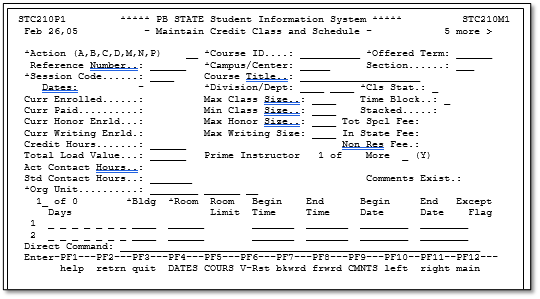
Step-by-Step Instructions for Adding a New Section of a Credit Course
Fields for Entry
The following fields need to be entered in the order given:
Direct Command: CU CC MC
- Select the ACTION CODE: A (Add)
- Course ID – Type the course ID (course number) of the course to be loaded, press the <TAB> key.
- Offered Term – Type the term identifier for the class, press the <TAB> key.
- Campus/Center – Select or type the appropriate campus that is offering the class (Note: if the class is being offered off-site, select the appropriate off-site number for the sponsoring campus. It will end in a 9).
- Press the <F5> key to load the course dictionary information. Press the <TAB> key five times.
- Session Code – Select or type the appropriate session that the class is being held in (e.g., Main, Express, 12-week). Please see Section D of this manual for detailed instructions on selecting a session. Press the <TAB> key.
- Division/Dept – No changes are needed; press <TAB> key twice.
- Class Status – The default value is “O” for open. If you temporarily do not want enrollments in the class, change this value to “H” for hold. Do not change to “U” for unavailable (class add date has passed) – the system will automatically update this field to “U” when the drop/add period for the class has expired. To cancel a class, change to “C” for cancel. Press the <TAB> key.
- Max Class Size – Enter the maximum class size (class limits). Please see the academic affairs class size guidelines policy manual in Section G of this manual for the assigned class size. This will later edit against the facility and room you have chosen to see if the room can meet this capacity.
- Time Block – This field will automatically be filled-in when the times are entered. The values are “D” for day, “E” for evening, “W” for weekend and “O” for other (classes with TBA in time). Note: Classes that start at 5:00 p.m. Monday through Thursday are labeled as “E” Evening; classes that begin at 5:00PM on Friday are labeled as “W” Weekend). For fully online classes, enter a “V” in this field – this will load the information on Days, Bldg./Room and Time automatically. Press the <TAB> key.
- Min Class Size – The default value is 1; enter a different minimum class size if appropriate. Press the <TAB> key.
- Max Honor Size – Enter the maximum number of honors students for this class (if applicable – only used for Honors Sections); press the <TAB> key.
- Max Writing Size – This field is currently not used; press the <TAB> key.
- Credit Hours – no changes are necessary in this field; press the <TAB> key.
- Load Value – this field is the equivalent of “points” for instructor load, and is loaded from the course dictionary – no changes are needed; press the <TAB> key
- STD Contact Hours – These are the standard class hours from the course dictionary (e.g., one credit hour=16 contact hours). Remember that each hour in credit is actually 50 minutes; press the <TAB> key.
- Org Unit – This is the organizational unit account number to which course costs will be charged. The account and qual-1 are automatically loaded from the course dictionary record. Type in the correct campus number. Press the <TAB> key 4 times.
- Days – Type in the days of the week that the class will be held, using the following abbreviations:
M (Monday)
|
T (Tuesday)
|
W (Wednesday)
|
R (Thursday)
|
F (Friday)
|
S (Saturday)
|
| U (Sunday) |
If the class is held on different times on different days, you can use the additional lines provided. If the class is TBA on the day field, type TBA in the first three positions for the days. For a fully online class, once the V is entered on Time Block, this field will display as ONLINE. Please remember that you cannot use TBA in days if you are using a “special” session (see Section D for details). Tab to the “BLDG” field.
- BLDG – Type in the letter designator for the building you are choosing. If the class building is TBA, type TBA on the building designator and room. Press the <TAB> key.
- Room – Type in the room number. If the building is TBA, room field must also be TBA. Press the <TAB> key.
- Begin Time – Enter the begin time for the class. The format for time entry is abbreviated such as 7P for 7:00 p.m. or 820A for 8:20 a.m. If time is TBA, type “TBA” in begin time field. Please remember that you cannot use TBA in times if you are using a “special” session (see Section D). Press the <TAB> key.
- End Time – Enter the end time for the class. If the class start time is TBA, leave this field blank.
Do not press enter until you have checked to see if the class needs any additional panels of information filled in.
Checklist for Additional Data Needed for a Credit Class
| |
Yes |
| Should this class be restricted from auditing? |
Panel 2 |
| Does this class require a special designator? |
Panel 2 |
| Is the class an e-learning class? |
Panel 2 |
| Do I need a schedule note for the student schedule? |
Panel 2 |
| Do I need to change the email type for the student? |
Panel 2 (please click here.) |
| Does the class have a special fee? |
Panel 3 |
| Is this a stacked (concurrent) class? |
Panel 4 |
| Does the class meet for additional meetings or days? |
Panel 5 |
Figure 2 - Panel 2 – Special Designators and Schedule Notes
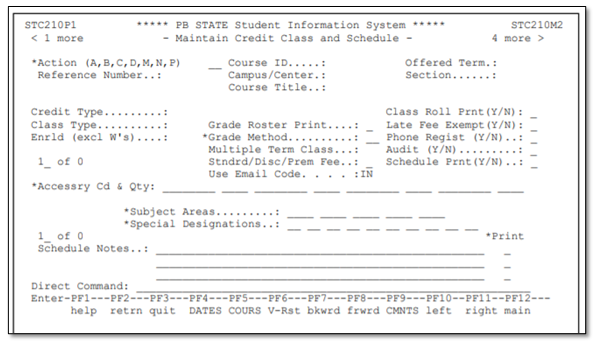
- Restricting a Class from Auditing – Panel 2
Certain classes (such as developmental education) cannot be audited. To restrict as class from being audited, change the field labeled “Audit” to “Y”.
- Class Requires a Special Designator contains the current special designators. For detailed instructions on their proper usage, please see Section D of this manual.
- Loading an Internet Class (Section Type) – Panel 2 To indicate that a class is delivered through technology the Special Designators field(s) must be filled in. Refer to the list of the current special designators and Section D of this manual for more information on using special designators for e-learning.
- Schedule Notes – Panel 2
If you need a special note or comment to print on the student’s schedule, type in the comment on the “schedule notes” line and place a “B” in the print field on the right side of the screen. The additional fields are available for internal notes, if no “B” is indicated the note will not print on the student’s schedule. Please see Section D of this manual for detailed instructions on class notes.
Course Special Designators
as of May 2020
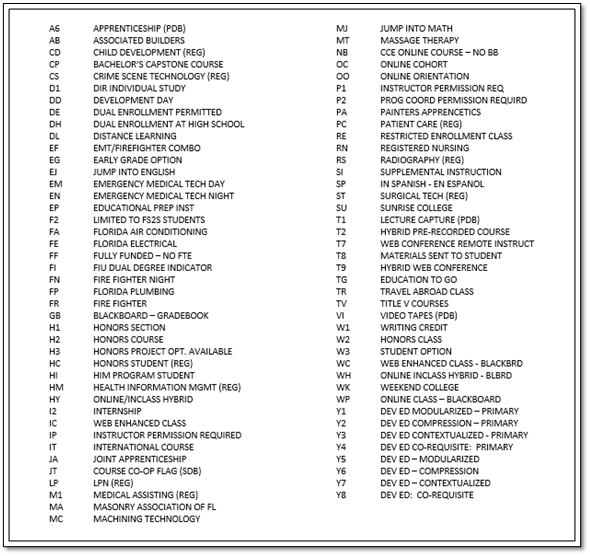
Figure 3 - Panel 3 – Special Fees
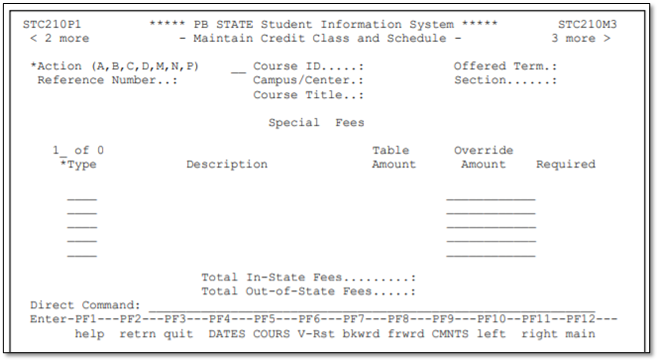
- Class with Special Fees – Panel 3
If the class has special fees, they would be listed on panel 3. These fees cannot be modified or waived. Please see Section N – e-learning for special instructions on e-learning fees.
Figure 4 – Panel 4 – Stacked Classes (Concurrent Classes)
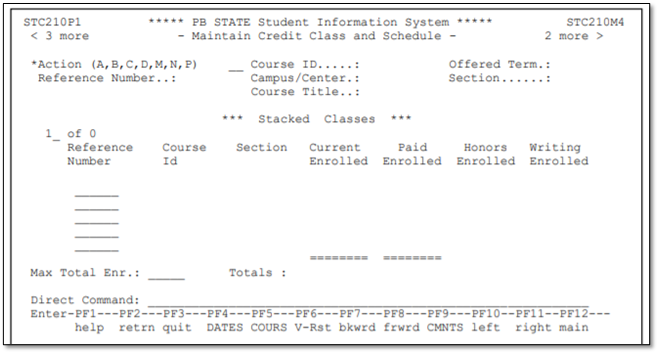
- Stacked (concurrent classes) – Panel 4
If the class meets concurrently with another class in the same room, the system will return the message “Time conflict found with class [ref]” ,where the [ref] is equal to the reference number of the class meeting at the same time in the same room. If this is the correct reference number for the concurrent class, move to panel 4 using the <F11> key and enter the reference number of the concurrent class.
Figure 5 - Panel 5 – Schedule Exceptions
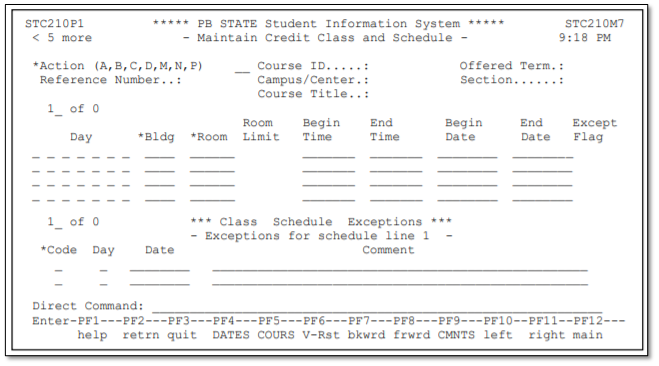
- Class meets for Additional Days – Panel 5
If a class meets for additional days outside the normal meeting days or on a closed day, fill in the dates and times of the additional class meetings. Use an “N” code to indicate the date on which the class will not meet, or use a “V” to indicate a variance in the meeting day (example – class will meet on a Tuesday instead of Monday).
Final Steps for Credit Class Entry:
After you have determined that all additional information has been entered on the panels (or that no additional information was necessary), press <ENTER>. The data you have entered will then be edited for accuracy using the programmed logic. Correct any data that the program edits as invalid. When all the data have passed the edits, you will be transported to the screen where you will make the instructor assignment. By default, the instructor schedule associated with the class has been loaded as TBA; you can leave the class as TBA or you can choose an instructor. Once you hit enter, the screen on page C-8 is displayed. Information on how to change an instructor once the class has been loaded is located in the specialized procedures of this section.
Adding an Instructor to a Class (initial class entry)
Figure 6 – Maintain Class Instructor Schedule
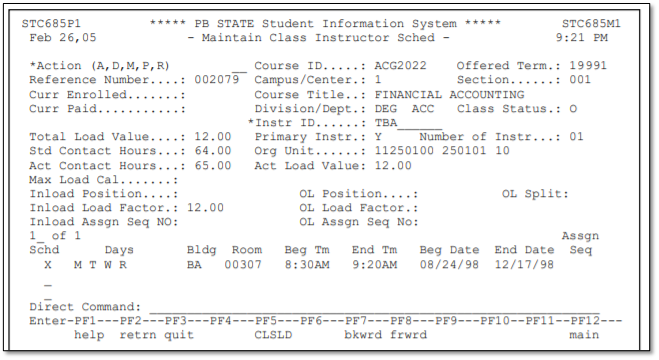
- Select the ACTION CODE: R (replace); press the <TAB> key
- On the field INSTR ID, press the <F1> key and select the appropriate instructor; if the instructor on the form is not listed, then the instructor has not been approved through Instructor Resource Management to teach the class then the class must remain TBA.
- If the instructor’s name is found, move your cursor and place it on the same line as the instructor’s name and press <ENTER>. Press <ENTER> again to replace the instructor. (For detailed instructions on how to replace an existing instructor, see section C.
That’s It – You Have Now Successfully Loaded a Credit Class Schedule!